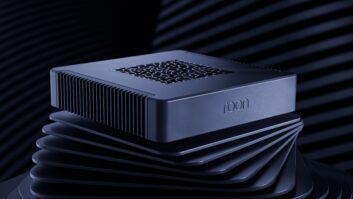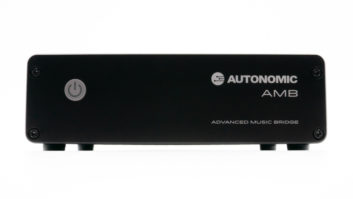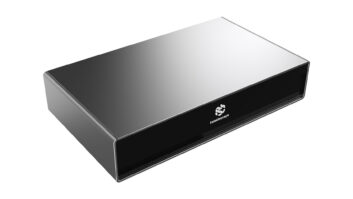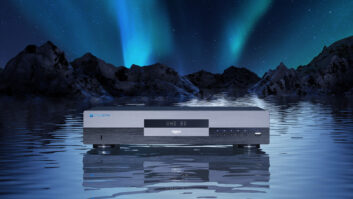
In lieu of its predecessor’s 500 GB magnetic hard disk, the Autonomic Controls MMS-2A sports a 128GB solid state drive, a move requested by integrators to decrease both the heat and noise generated by the server. As I was installing and configuring Autonomic Controls’ new MMS-2A Mirage Media Server, it occurred to me just how much the music distribution market has changed in the three years since I installed the original MMS-2. At one end of the ever-diversifying music spectrum, low-bitrate streaming has become so prevalent that if your dishwasher doesn’t have AirPlay connectivity and a Spotify app, it’s woefully out of date. And at the other end, bandwidth-hogging high-res audio is finally taking off in a meaningful way. Brave is the company that tries to compete meaningfully in both areas, but that’s exactly what Autonomic has done with the MMS-2A, as well as its bigger brother the MMS-5A.
So, what’s different from last time around? For one thing, obviously, it’s the form factor. Autonomic has eschewed the 2RU, less-than-half-rack-width form factor of the MMS-2 in favor of a 1RU, full-width chassis that looks more like a piece of AV gear than a mini-computer, and comes with rack ears to boot. Around back, the mini jack audio outputs have been replaced with high-quality RCA stereo outputs and a coaxial digital out, along with a USB audio output for use with a separate standalone DAC, should you so choose. The combined effect is that the MMS-2A looks like a much more expensive piece of gear than its predecessor, despite selling for the exact same price ($1,995 MSRP).
Under the hood, things have changed a good bit as well. In lieu of its predecessor’s 500 GB magnetic hard disk, the MMS-2A sports a 128GB solid state drive, a move requested by integrators to decrease both the heat and noise generated by the server. I was slightly disappointed by this when I first noticed it, since my music collection has only grown in the past three years and 128 GB certainly isn’t sufficient to house it all–much less my wife’s music collection on top of that. In the end, though, it ended up not being as big a deal as I initially feared, because the bulk of my collection consists of 256kbps VBR MP3 and AAC files, which are easy enough to stream over the network or directly from my phone via the MMS-2A’s built-in AirPlay receivers.
So for now I’m leaving my lossy files off the MMS-2A and reserving its solid state drive for my burgeoning high-res collection (most of it, at least.) The MMS-2A supports playback of files up to 96kHz/24-bit (with the MMS-5A supporting up to 192/24), so there are a few higher resolution files that didn’t make the cut. But a good 95 percent of my high-res collection is now housed conveniently right in my AV rack in the home theater and instantly accessible. And if that 128 GB of internal storage should prove someday to be insufficient, the server also supports external USB storage and network-attached storage as well.
Of course, as has always been the case with Autonomic’s offerings, hardware is only part of the equation. The true strength of the brand still lies in its syncing software, its graphical user interface, its robust support for advanced control systems, and of course its integration of streaming audio and cloud services. In many respects, the core of the software experience hasn’t changed drastically since the last time we took a long, hard look at an Autonomic product. The Mirage Remote Media Sync software still boasts tons of flexibility and allows you to easily select which files from which folders will be copied to the MMS-2A’s internal storage over the network. The browser-based setup screen also remains a strong point, allowing you to selectively enable or disable either of the server’s zones, as well as set their output to variable or fixed gain, set up network connectivity, and also fill in account info for iTunes, Amazon Cloud Drive, Last.fm, Pandora, Rhapsody, SiriusXM, Slacker Radio, Spotify, and TuneIn.

Whether you use one of Autonomic’s control modules or simply operate it with the free Mirage Media Controller app for iOS devices, there’s no doubt that the MMS-2A is a snappier, more responsive devices than its forebear. The biggest change in terms of setup is that Autonomic has taken over the development of its Control4 driver, and the installation of said driver is much more straightforward than before. There’s also a new driver in beta testing now that taps into the enhanced music experience introduced in Control4 OS 2.6, including the enhanced artwork, better multi-zone control, and one-touch access to all of the devices built-in streaming apps.
Whether you use one of Autonomic’s control modules or simply operate it with the free Mirage Media Controller app for iOS devices, there’s no doubt that the MMS-2A is a snappier, more responsive devices than its forebear. Searching, setting up playlists, and starting a stream are all lickity-split, and although Autonomic may not have the prettiest UI on the block anymore (that award probably goes to the upstart BlueSound system), it’s certainly one of the most intuitive and nimble.
One new feature that enhances the navigation experience and definitely bears mentioning is Autonomic’s proprietary TuneBridge feature. Say you’re listening to RAC’s new album Strangers from your personal music library. Press the little TuneBridge button at the bottom of the screen and you can instantly search for the album or artist on Spotify or Rhapsody, or even instantly create a Pandora radio station. And that works between streaming services too. You can create a Pandora station from Spotify, or find a Spotify album from Pandora. It’s a wonderful way of unifying the music listening experience, and it’s indicative of the way Autonomic continues to innovate.
If I have one regret, it’s that I’ve made it all the way to the end of this review without discussing audio quality. Given the limited space left, it will have to suffice to say that I was impressed. I relied entirely on the MMS-2’s RCA outputs to get a sense of its internal digital-to-analog conversion capabilities, and I came away wholly satisfied by the detail, the low noise floor, and the dynamic impact. That’s definitely not a given for a product capable of serving as the centerpiece of a staggering 96-zone distributed audio system, so it’s much appreciated.
914.598.1647
autonomic-controls.com
Kudos
Autonomic continues to demonstrate its commitment to innovation with the MMS- 2A. The hardware is a vast upgrade over its predecessor in virtually every way, and the software and integration capabilities of the system continue to improve.
Concerns
Despite the fact that the move from magnetic storage to SSD s is much appreciated, the drop in storage space from 500 GB to 128 might be a concern for some customers.
Product Specs
Streaming Services: Pandora internet radio, Rhapsody, SiriusXM, Internet Radio, Spotify, Slacker Radio, TuneIn; add-on URLs for radio stations; guest computer/device streaming via Airplay
Audio Formats: .aif, .aifc, .aiff, .au, .cda, .flac, .m4a, .m4p, .mp2, .mp3, .mpa, .rmi, .snd, .wav, .wma, .wpl
Internal Storage: 128 GB SSD Hard Drive. Supports approximately 25,000 songs.
External Storage: Expandable storage via USB external hard drives or network shared storage.
Pre-Amp Audio Output: 1x analog, unbalanced, stereo, line level audio output
Digital Audio Output: 1x Stereo PCM, Coaxial, RCA type; 1x Stereo USB.
Warranty: 2-year limited warranty







